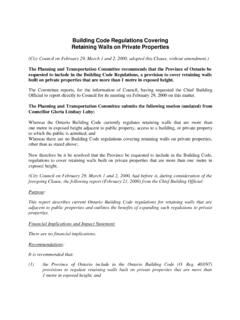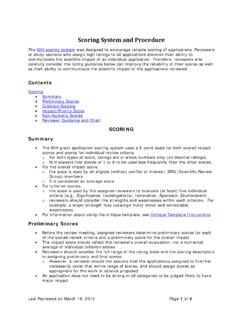Transcription of TOONO OFFICIAL PLAN 4-1 - Toronto
1 CHAPTER FOUR. 4. LAND USE DESIGNATIONS A new comprehensive Zoning By-law will be the key regulatory instrument that Land use designations are among the OFFICIAL Plan's key implements the OFFICIAL Plan policies and provides regulations and standards that implementation tools for achieving the growth strategy set out in shape the City's built form and land use. Chapter Two to direct major growth to some parts of the City and The Zoning By-law will create a framework away from others. Each land use designation establishes the general of regulatory certainty, consistency and uses that are provided for in each designation. Together, they describe clarity. The Zoning By-law regulations will be carefully balanced to identify the where housing can be built, where stores, offices and industry can commonalities and recognize the differences locate and where a mix of uses is desired. The land uses provided for of the City's various neighbourhoods. in each designation are generalized, leaving it to the Zoning By-law to prescribe the precise numerical figures and land use permissions that will reflect the tremendous variety of communities across the City.
2 The development criteria set out in this chapter for the various land use designations are critical considerations that apply when development proposals are evaluated, but they do not constitute the only considerations. All of the policies of the Plan apply when evaluating development proposals. Designations that Reinforce existing Physical Character Four land use designations shown on the Plan's land use maps, Neighbourhoods, Apartment Neighbourhoods, Parks and Open Space Areas and Utility Corridors, will help to protect and reinforce the existing physical character of these areas. Toronto 's hundreds of low scale residential neighbourhoods, with their distinctive character, together with local institutions, retail and services that serve their populations, are prized by residents. These Neighbourhoods, as well as the Apartment Neighbourhoods, composed largely of apartment buildings and differentiated because of the scale of buildings, share the objectives for contextual stability, better amenities and environmental sustainability.
3 Our extensive network of parks, valleys, watercourses and natural areas across the City, captured by the Parks and Open Space Areas designation, are to be protected and improved to provide respite, recreation, ecological and hydrological functions and beauty for a growing City. Finally, the Utility Corridors designation is placed on the hydro and rail corridors to preserve the central nervous system of the City . distributing heat, light, power, people and goods throughout the City. Designations for Growth Four land use designations distribute most of the increased jobs and population anticipated by the Plan's growth strategy: Mixed Use Areas, Employment Areas, Regeneration Areas and Institutional Areas. Toronto . 4-1. OFFICIAL PLAN. LAND USE DESIGNATIONS. CHAPTER FOUR. Many of the properties within Downtown, the Centres and along the Avenues are designated Mixed Use Areas, encouraging a broad range of commercial, residential, institutional and open space uses. Flexibility is provided for future redevelopment in these areas to accommodate increases in population and jobs along transit lines.
4 Toronto 's industrial districts and suburban office parks are designated Employment Areas, reflecting the broad objective of retaining our Employment Areas as places of business and developing and intensifying job growth within these areas, especially those areas that can be reached by transit. Another location for future job growth for a maturing City and region are Institutional Areas, where our hospitals, university and college campuses, and key government centres can reinforce the new economy linkages needed to sustain Toronto 's economic future. The Regeneration Areas designation is applied to areas with significant vacant lands and/or buildings and in need of revitalization as a means of fostering growth and physical change. Regeneration Areas policies will attract investment, fill the buildings and bring new life to the streets. NEIGHBOURHOODS. Toronto 's hundreds of Neighbourhoods contain a full range of residential uses within lower scale buildings, as well as parks, schools, local institutions and small-scale stores and shops serving the needs of area residents.
5 Lower scale residential buildings in Toronto 's Neighbourhoods consist of detached houses, semi-detached houses, duplexes, triplexes and various forms of townhouses as well as interspersed walk-up apartments with or without elevators that are four storeys or less. Over the past half-century, scattered high-rise apartment buildings were constructed in the midst of otherwise low scale residential neighbourhoods. The existing higher scale apartments are recognized but no new ones are permitted in areas designated as Neighbourhood. More recently, as the economy has changed, thousands of Torontonians have begun working from their homes, creating valuable economic activity, enhancing safety by providing eyes on the street , and reducing trips to work. These home occupations are provided for in Neighbourhoods across the City. Historical development patterns have also added to the variety of local educational uses in Neighbourhoods. Policies regarding the suitable integration of schools within the context of Neighbourhoods are an important consideration for ensuring quality of life.
6 Toronto . 4-2. OFFICIAL PLAN. LAND USE DESIGNATIONS. CHAPTER FOUR. Policies 1. Neighbourhoods are considered physically stable areas made up of residential uses in lower scale buildings such as detached houses, semi-detached houses, duplexes, triplexes and townhouses, as well as interspersed walk-up apartments that are no higher than four storeys. Parks, low scale local institutions, home occupations, cultural and recreational facilities and small-scale retail, service and office uses are also provided for in Neighbourhoods. Low scale local institutions play an important role in the rhythm of daily life in Neighbourhoods and include such uses as: schools, places of worship, community centres, libraries, day nurseries and private home daycare, seniors and nursing homes and long-term care facilities , public transit facilities , utility and telecommunications installations, and public services and facilities provided by the local, provincial and federal governments. 2. Schools will provide open space for outdoor student activities and landscaping and will be designed and operated to limit noise, privacy and traffic impacts on neighbouring residents.
7 3. Small-scale retail, service and office uses are permitted on properties in Neighbourhoods that legally contained such uses prior to the approval date of this OFFICIAL Plan. New small-scale retail, service and office uses that are incidental to and support Neighbourhoods and that are compatible with the area and do not adversely impact adjacent residences may be permitted through an amendment to the Zoning By-law, where required, on major streets shown on Map 3, with the exception of portions of streets which have reversed lot frontages. To maintain the residential amenity of Neighbourhoods, new small-scale retail, service and office uses will: a) serve the needs of area residents and potentially reduce local automobile trips;. b) have minimal noise, parking or other adverse impacts upon adjacent or nearby residents; and c) have a physical form that is compatible with and integrated into the Neighbourhood. 4. Apartment buildings legally constructed prior to the approval date of this OFFICIAL Plan are permitted in Neighbourhoods.
8 Development Criteria in Neighbourhoods The stability of our Neighbourhoods' physical character is one of the keys to Toronto 's success. While communities experience constant social and demographic change, the general physical character of Toronto 's residential Neighbourhoods endures. Physical changes to our established Neighbourhoods must be sensitive, gradual and fit the existing physical character. A key objective of this Plan is that new development respect and reinforce the general physical patterns in a Neighbourhood. Toronto . 4-3. OFFICIAL PLAN. LAND USE DESIGNATIONS. CHAPTER FOUR. Scattered throughout many Neighbourhoods are properties that differ from the prevailing patterns of lot size, configuration and orientation. Typically, these lots are sites of former non-residential uses such as an industry, institution, retail stores, a utility corridor, or are lots that were passed over in the first wave of urbanization. In converting these sites to residential uses, there is a genuine opportunity to add to the quality of Neighbourhood life by filling in the gaps and extending streets and paths.
9 Due to the site configuration and orientation, it is often not possible or desirable to provide the same site standards and pattern of development in these infill projects as in the surrounding Neighbourhood. Special infill criteria are provided for dealing with the integration of new development for these sites, and for intensification on existing apartment sites in Neighbourhoods. 5. Development in established Neighbourhoods will respect and reinforce the existing physical character of each geographic neighbourhood, including in particular: a) patterns of streets, blocks and lanes, parks and public building sites;. b) prevailing size and configuration of lots;. c) prevailing heights, massing, scale, density and dwelling type of nearby residential properties;. d) prevailing building type(s);. e) prevailing location, design and elevations relative to the grade of driveways and garages;. f) prevailing setbacks of buildings from the street or streets;. g) prevailing patterns of rear and side yard setbacks and landscaped open space.
10 H) continuation of special landscape or built-form features that contribute to the unique physical character of the geographic neighbourhood; and i) conservation of heritage buildings, structures and landscapes. The geographic neighbourhood for the purposes of this policy will be delineated by considering the context within the Neighbourhood in proximity to a proposed development, including: zoning;. prevailing dwelling type and scale; lot size and configuration; street pattern; pedestrian connectivity; and natural and human-made dividing features. Lots fronting onto a major street shown on Map 3. and designated Neighbourhoods are to be distinguished from lots in the interior of the block adjacent to that street in accordance with Policy 6 in order to recognize the potential for a more intense form of development along major streets to the extent permitted by this Plan. The physical character of the geographic neighbourhood includes both the physical characteristics of the entire geographic area in proximity to the proposed development (the broader context).










